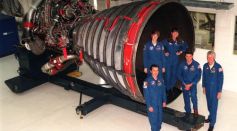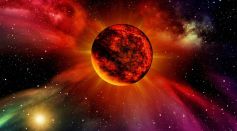Tags: Exoplanet

Nearby Exoplanet's Tail Grows to 350,000 Miles, Outshining Earth
James Webb Space Telescope Found Potentially Habitable Exoplanet With Atmosphere, Liquid Water
Extreme ‘Hot Jupiter’ Exoplanet Close to Earth Rains Down Glass, Stinks Like Rotten Egg

NASA’s Chandra X-Ray Observatory Utilizes Star Radiation To Hunt for Habitable Exoplanets: How Does This Help Know if Planet Can Sustain Life?

Exoplanet GJ 3470b Reveals Surprising Sulfur Dioxide in Atmosphere, Defying Planet Formation Theories
New Earth Found? Earth-Like Exoplanet Found in Habitable Zone Could Potentially Support Life

Bizarre Planet 'WASP-193b' Found To Have the Density of Cotton Candy Despite Its Enormous Size, Making It Second-Least Dense Exoplanet Ever Discovered

James Webb Space Telescope Finds Distinct Carbon-Rich Atmosphere Around '55 Cancri E' Exoplanet
NASA’s JWST Detects Clouds of Melted Rock Covering the Night Side of Hot Exoplanet WASP-43b
Unique Exoplanet Found Lurking in Habitable Zone of 2 Stars
Tidal Storm Makes Exoplanet 'Literally Glows at Optical Wavelength' [Study]
Purple Photosynthesis: Experts Suggest Aliens May Not Be Found on Green Earth-Like Planets
Extraterrestrial Light: JWST Detects First Spectrum of a TRAPPIST-1 Planet
Super-Earth LHS 3855b: Scientists Discover First Exoplanet With Confirmed One-to-One Tidal Locking
James Webb Space Telescope To Hunt For Newborn Exoplanets Forming Around Infant Stars
Egg-shaped Exoplanet WASP-12b Racing Towards Fiery Demise, Study Suggests
JWST Finds Exoplanet Covered in Deep Boiling Water; Could This Water World Harbor Life?
Atmospheric Destruction Due to Extreme Space Environment Leaves Short-Orbit Exoplanet TRAPPIST-1e Uninhabitable
2 Interstellar Interlopers ’Oumuamua and Borisov Suggest There Could Be More Celestial Nomads

Hubble Discovery: Water Vapor Found in Atmosphere of Smallest Known Exoplanet
Most Popular

Microplastics Are Everywhere — How Plastic Pollution Threatens Wildlife, Soil, and Water

Brain Health Aging Guide: Effective Strategies for Cognitive Decline Prevention and Lower Dementia Risk

How Scientists Use Radio Telescopes to Search for Alien Signals Across the Universe

Mitochondrial Health and Aging: How Cell Energy Drives Modern Anti-Aging Science





